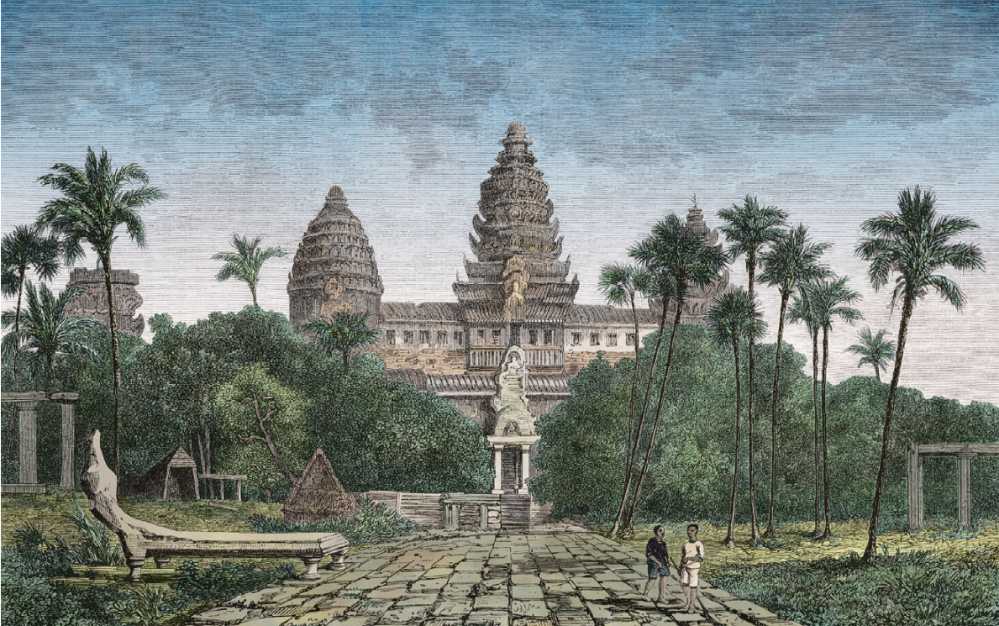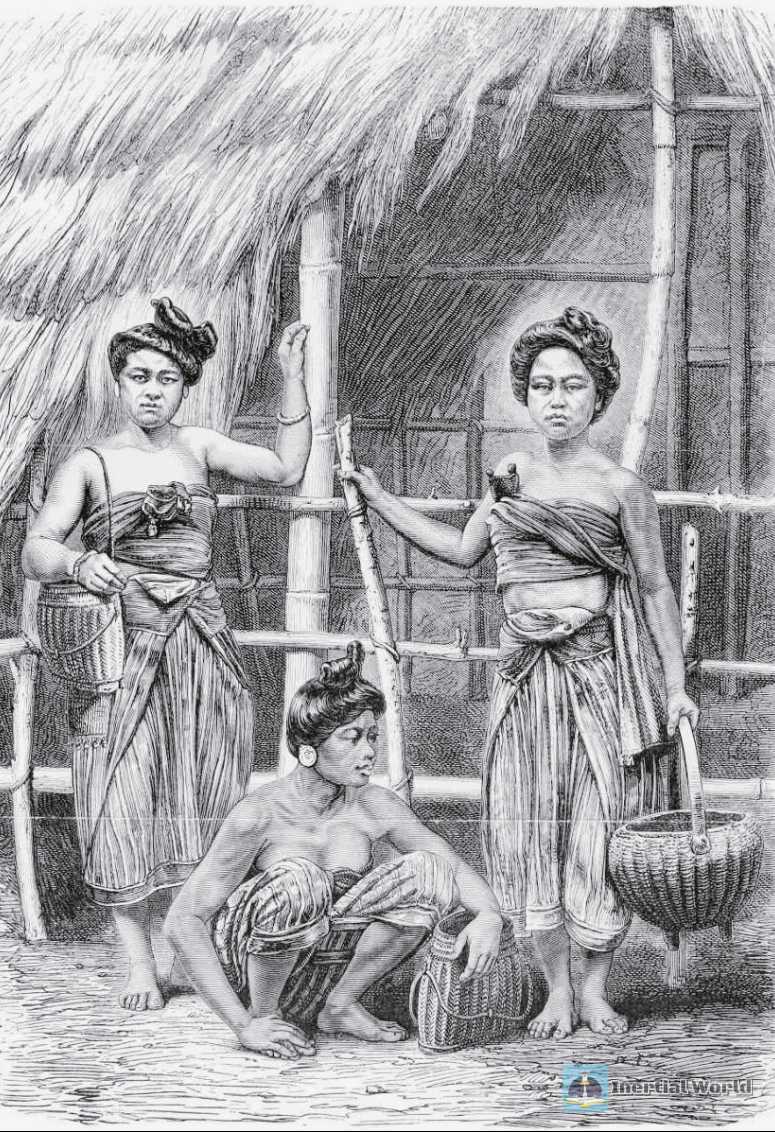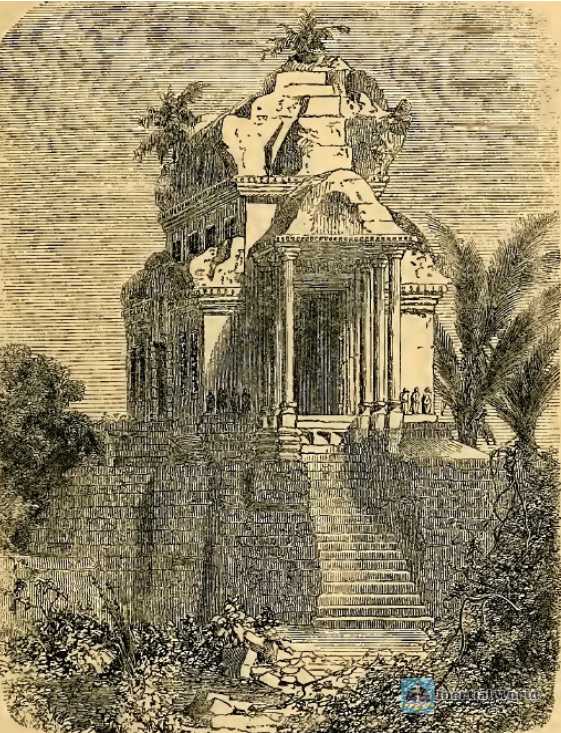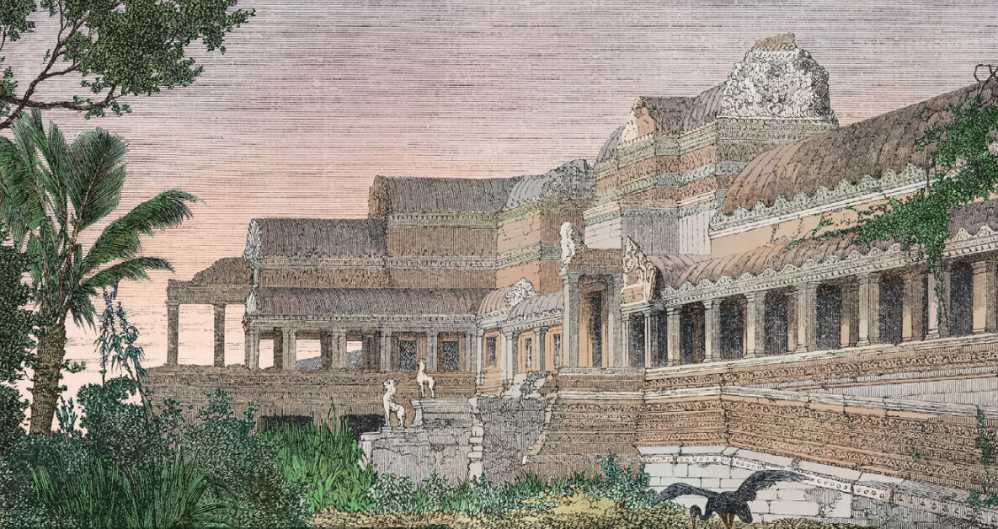January 1861, northwest of Cambodia, 5.5 kilometers north of Siem Reap. In this tropical rainforest that blocks out the sun, there are only vines, singing insects and flying birds. There are rotten leaves and animal corpses everywhere, and even locals rarely set foot. Frenchman Henri Mouhot has been walking for 5 days. The wind blowing from Tonle Sap Lake has disturbed the huge leaves that block his eyes. The tropical forest is steaming with mist, and the few Khmer people accompanying him are exhausted and start to complain quietly. Mouhot turned a deaf ear to this and continued to move forward. He traveled thousands of miles, took the Nanyang waterway, and entered the Indochina Peninsula in southeast Asia via Singapore and Bangkok. He picked butterfly specimens along the way and suffered a lot. In the mud, his horse boots stepped on the hard stone road. A premonition in his heart became clearer and clearer-dawn was coming.
On an ordinary day in the Indochina Peninsula, five brilliant spires suddenly appeared in front of people in the morning light, and a secret hidden for 400 years was awakened. At this moment, Mouhot held his breath.
Explore the world
Like some geniuses who streaked across the sky like comets, Mouhot only lived for a short 35 years. But the turning point in his life began when he came into contact with natural history-in 1856, he was 30 years old.

Henri Mouhot grew up on the border between France and Switzerland and lived in Russia for 10 years as a professor of linguistics. In the 19th century when he lived, the Industrial Revolution greatly liberated people’s imagination and inspired the theme of adventure and exploration. Mouhot’s blood also flows with the factor of restlessness in the study and is full of curiosity about new things. He traveled around Europe and the Mediterranean with his brother Charles. In the process of exploring the world, he learned the latest silver plate photography at the time and became fascinated by natural history.
Natural history is an ancient and interesting subject. As early as the 4th century BC, brave and fearless naturalists measured nature with their feet and explored every inch of the unknown. With the great maritime discoveries and crossing the oceans, these scholars expanded their footsteps to the new world. It can be said that naturalists have greatly expanded human knowledge of nature and the world with their first-line research results. They know astronomy and geography, and are involved in biology, plants, animals, medicine, minerals and other disciplines. Among them, masters are as brilliant as stars: Aristotle in ancient Greece, Leonardo da Vinci in the Renaissance, Darwin on the Beagle, and famous humanities masters Rousseau, Goethe, Thoreau, etc., all belong to naturalists in a broad sense.
In the 19th century, those countries that made great strides into industrialization (especially the old colonial empires), driven by the inherent expansion of land resources and capital, have extended their tentacles of exploration to the world. Before guns and currency arrived in the New World, naturalists and missionaries had already taken the lead and walked a long way.
The great times changed the fate of individuals. Natural history fascinated the original young linguist Henry Mouhot, like a new life. In the same year, he married a girl who shared the same values as himself - the daughter of British explorer Mungo Parker. From then on, he was unstoppable on the road of exploring the world.

In 1857, Mouhot began his journey in Indochina. The climate here is hot and humid, and there are rich tropical flora and fauna, which is different from the European continent. He traveled all the way and collected animal specimens all the way, and it took several years in a flash. At that time, Indochina gradually showed a situation of being divided, and Vietnam, Laos, and Cambodia fell into the hands of France. In fact, the French began to covet Cambodia as early as the early 19th century. The knowledge of the customs and features of Indochina was also spread to the European continent. The most important of these is the French version of "The Customs of Zhenla".
In 1819, a French sinologist, J.P. Remusat, read a strange book about the customs and people of the ancient Cambodian Kingdom of Zhenla, called "The Customs of Zhenla", written by Zhou Daguan, a geographer of the Yuan Dynasty in China.
Zhou Daguan was also in his 30s when he wrote this book. He recorded in the book that in the first year of Yuanzhen (1295), Emperor Chengzong of Yuan Dynasty planned to gain the allegiance of the Zhenla Dynasty and the surrounding small countries, and sent a delegation to the Kingdom. Zhou Daguan was a member of the delegation. They set off in February of the following year, arrived in Zhenla five months later, and stayed for a year before returning home. The journey lasted for a year and a half, and he wrote this book based on his own experiences. Remusat, who was proficient in Chinese, Mongolian and Manchu, translated this book "The Customs of Zhenla" into French. Unfortunately, this book did not cause much response in France at that time. It was not until 1860 that Mouhot, who traveled to the Indochina Peninsula, read this book.
Guidance from Zhou Daguan
The Cambodian Customs is not thick, with only about 8,500 words. It is a travelogue of a scholar with rich connotations! But it was enough to deeply shock Mouhot. Holding Zhou Daguan’s words, he followed the map all the way, passing through the big river and big port with "old trees and vines, yellow sand and white reeds", and passing through the dangerous tropical jungle with "old trees and vines, dense shade and mist, and the sounds of animals and beasts mixed in between". What he saw and heard constantly showed that Zhou Daguan’s previous records were true.
If Mouhot was initially attracted by the rare animals, flowers and plants recorded in the book, the fine colors include emerald hair, ivory, rhino horn, and yellow wax; the ivory colors include agarwood, cardamom, painted yellow, purple stem, brocade oil, and jadeite. Later, he gradually developed a strong interest in the ancient kingdom of Zhenla. "Zhenla", also written as "Zhanla", is located in present-day Cambodia. Some people believe that "Zhenla", "Khmer" and "Khmer" are all the same word with different translations. In the land of today’s Cambodia, a country had already appeared in the 1st century AD, namely "Funan" in the history books of the Han Dynasty. During the Sui and Tang Dynasties, "Funan" was replaced by its original vassal state "Zhenla". In the 13th century when Zhou Daguan lived, it was the era when the civilization of the Kingdom of Zhenla was the most brilliant and influential, known in history as the "Angkor Dynasty Period or the "Khmer Empire Period"

The Angkor Dynasty existed for about 500 years. At its peak, Zhenla was the most powerful country in Southeast Asian history, and almost the entire Indochina Peninsula was included in its territory, including most of today’s Thailand, southern Laos and southern Vietnam. Its writing, religion (Hinduism in the early days, Southern Buddhism in the later days), and system have a sample effect, radiating to the countries of Indochina Peninsula.
The Angkor people have devout religious beliefs. In the tropical rainforest of more than 400,000 square kilometers, they built the royal city of Angkor and more than 600 temples of various sizes, and built a large-scale farmland water conservancy irrigation system. Food is abundant, and there can be three to four harvests a year. According to Zhou Daguan, the Angkor Dynasty was a land of wealth and power, like a paradise on earth. Many Chinese who came to do business were reluctant to leave, and intermarried with the locals and settled there. These people were called "Tang people" by Cambodians.
When reading this notebook, Mouao was very curious about the fate of such a powerful dynasty. Why did it disappear without a trace? The reason can be traced back to the endless disputes and love-hate relationships between Khmer (Cambodia), Siam (Thailand) and Champa (an ancient country located in the south-central part of Vietnam today). It is said that Angkor was once renamed "Siem Reap" to "defeat the Siamese".
In ancient times, the Thai people who migrated from southwestern China to the south were once subject to the Angkor Dynasty and once followed the Angkor King Jayavarman VII to attack Champa. However, after Jayavarman VII died, the Thais took advantage of the weakening of the Angkor Dynasty to establish themselves, fought with Angkor for years, and forced the then Angkor ruler King Soriyopo to move the capital to Phnom Penh in 1432. As Angkor was close to the borders of Cambodia and Siam, it was easily affected by the war. Also, considering the threat of floods in Tonle Sap Lake and wild animals in the forest, the Thais never stayed here for a long time, leaving only the empty Angkor.
For centuries, the local Khmer people went into the forest to hunt and discovered these magnificent temples, which even attracted many devout Buddhists to practice here. However, Angkor still could not escape the fate of being forgotten by the times, and gradually became a legend deep in the rainforest.

Angkor Wat Reappears
It is impossible to describe the feeling of trekking through this miasma land. Those trees and huge leaves that look exactly the same have always blocked people’s sight. Even under the leadership of the local Khmer, Mouhot’s team lost their way several times.
Every time Mouhot’s boots sank into the mud, his heart would tremble. The murderous swamp may be right under your feet, and avoiding jungle beasts is a daily necessity. The huge poisonous mosquitoes are hard to guard against, and it is not uncommon for horses to be bitten to death in this dense forest. What is more challenging is the doubt about the existing route. Does the legend of the ancient city of Angkor really exist?
Led by strong intuition and firm belief, Mouot finally reached the dawn full of discoveries after many disappointments and hopes--disappointments--hopes. After the five pagoda spires appeared, the further he went, the clearer he could see the dark towers outlined by the morning light. Until a huge ancient city ruins appeared in the neat moat, Mouot finally saw the famous Angkor Wat today. This big city faces east and west. Because of the moat, the raging tropical rainforest failed to invade the city. The collapsed pagodas, tilted door pillars, broken door beams and exquisite reliefs in the morning mist were like a hazy dream, which shocked Mouot speechless.
Angkor Wat, also known as Angkor Thom, is located at the southernmost end of the ancient city ruins of Angkor and is the closest royal city building to Siem Reap. It is said that Angkor Wat was built by Suryavarman II, the Khmer king, in the early 12th century. In Zhou Daguan’s records, many people believed that this was a miracle completed overnight. Later, archaeological discoveries showed that Angkor Wat was not a miracle, but that it took the whole country’s efforts and about 35 years to build it.
According to the records of "Records of Cambodia", this big city "is 20 miles in circumference, with five gates, each with two layers. Only two gates are opened to the east, and the rest are single gates. There is a huge moat outside the city, and there are bridges outside the moat." Mouot passed the "bridge" - that is, the suspension bridge outside Angkor Wat, crossed the "huge moat outside the city" - that is, the huge moat, and entered Angkor Wat. Because of the wind and rain, the exterior of this big city looks black and gray, and has a cold beauty.
Mouot will have to go through another shock next - facing those completely unfamiliar Buddha statues. These Buddha statues look huge, some are even tens of meters high, and the plastic arts are completely beyond his aesthetic experience. From the outer edge of the moat to the main building in the city, the outer walls, inner walls, and the surroundings of the buildings are full of such Buddha reliefs. From a distance, this big city seems to be held up by the Buddha statues.
Angkor Wat was originally a Hindu temple, and later converted to Buddhism. Legend has it that it was this move that angered Lord Shiva, which led to the decline of the Angkor Dynasty. In terms of the main structure, Angkor Wat is composed of the temple mountain, the standard national temple of the emperor, and the later coaxial gallery design. The temple symbolizes the residence of the gods--Sumi Mountain: the five plum blossom-shaped temple towers in the center symbolize the five peaks of Mount Xumi, while the city walls and moats symbolize the mountains and seas surrounding Mount Xumi.
Angkor Wat is a typical representative of Khmer architectural style, which is also called Angkor style in later generations. The architectural features include: pointed arch-shaped, lotus bud-shaped sawtooth temple towers; semi-gallery and wide corridors; axial gallery connecting the corridor; and cross-shaped platform on the main axis of the temple.

As for the graceful flying goddess, the bas-relief on the stone, and the complete story scenes taken from Hindu mythology, Angkor Wat is unique from other temples in the world.
At that time, Henri Mouhot left such an exclamation: "One of the temples - comparable to Solomon’s Temple, probably from the hands of some ancient Michelangelo - can also occupy a place among our most beautiful buildings. It is more magnificent than anything left to us by Greece or Rome. The contrast between it and the current barbaric state of the country is heartbreaking." In the next few days, Mouhot climbed the 670-meter-high Phnom Bakheng Mountain and discovered other parts of the Angkor ruins including "Great Angkor" (Angkor City) in the distance. In this art palace covering an area of 310 square kilometers, he saw more amazing carving techniques, fishing and hunting, farewell, war, ancient legends, religious stories, etc.
Since then, the name of naturalist Henri Mouhot is destined to be marked in the history of world exploration - he compiled what he saw along the way into a diary, and finally became a travelogue with pictures and texts "Travels in the Kingdoms of Siam, Cambodia and Laos". This discovery aroused his great interest in Cambodia. In the following months, he continued to go deep into the tropical jungle, but unfortunately he was infected with malaria and died in 1861. He was ultimately unable to leave the land of Indochina.
After Mouhot’s death, his works were published by his brother Charles. Five years later, a photographer named Emile Kissel read his works and traveled thousands of miles to Angkor Wat to take a group of photos of Angkor surrounded by jungle. The whole of France was truly shocked. It is worth mentioning that Cambodia was colonized by France for 90 years, and it was not until 1953 that it truly gained national independence and self-determination.




















